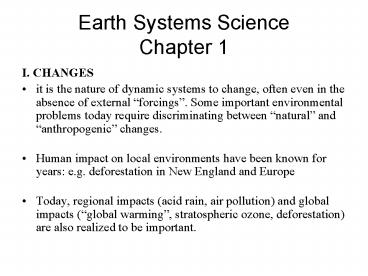Earth Systems Science Chapter 1 - PowerPoint PPT Presentation
1 / 28
Title:
Earth Systems Science Chapter 1
Description:
... problems today require discriminating between 'natural' and ' ... US-Mexico border in California, area of 24 by 30 km. El Centro, CA. Mexicali-Calexico ... – PowerPoint PPT presentation
Number of Views:31
Avg rating:3.0/5.0
Title: Earth Systems Science Chapter 1
1
Earth Systems ScienceChapter 1
- I. CHANGES
- it is the nature of dynamic systems to change,
often even in the absence of external forcings.
Some important environmental problems today
require discriminating between natural and
anthropogenic changes. - Human impact on local environments have been
known for years e.g. deforestation in New
England and Europe - Today, regional impacts (acid rain, air
pollution) and global impacts (global warming,
stratospheric ozone, deforestation) are also
realized to be important.
2
- II. 3 MAJOR THEMES OF THE TEXT
- 1. Global environmental issues (global warming,
stratospheric ozone, deforestation) - 2. Paleo-environmental changes
- 3. Systems
- Our goal in this class is to cover 1 and 2 as
we go, but to really focus on 3. - The Earth System atmosphere, hydrosphere,
lithosphere, biosphere. In this course we focus
on the first three, the continuation of this
course will focus more on the biosphere.
3
(No Transcript)
4
- III. GLOBAL CHANGE ON SHORT TIME SCALES
- 1. Global Warming
- 2. Stratospheric Ozone Depletion
- 3. Deforestation and Loss of Biodiversity
- How are these problems related?
- How are they examples of dynamic systems /
dynamic equilibrium
5
- 1. GLOBAL WARMING
- define global warming, greenhouse effect
- EVIDENCE OF GREENHOUSE GAS CHANGES
- CO2 fluctuations Keeling curve, and ice core
data - Other greenhouse gases methane (CH4), nitrous
oxide (N20), and CFCs. - EVIDENCE OF TEMPERATURE CHANGES
- Surface temperature observations
6
The Keeling Curve
7
Ice Core Data and The Keeling Curve
8
Warming over the past 50 years
- Simulations with natural and human factors match
observations best - Correspondences increase with time
- Probability is low that natural-only earth
would have such correspondences
9
The Land Surface We see
that the physical processes that occur at the
surface of the Earth are, have to be, in the
middle of the controversy over the impact of
human activities on climate, since there is where
we live and it is over land that most of the
anthropogenic climate forcing is found.
10
(No Transcript)
11
Deforestation in the U.S. Loss of Virgin Forests
12
Deforestation and urbanization are human
activities that impact the land surface
heterogeneities, as the example of fish-bone
pattern of deforestation typical of small farm
holdings in Rondônia, Brazil, illustrates.
Deforestation of Rondônia within 13 years
(Landsat image) This introduces small-scale
heterogeneities at the surface.
13
US-Mexico border in California, area of 24
by 30 km.
El Centro, CA
Mexicali-Calexico
14
Surface Temperature Observations
15
http//www.cru.uea.ac.uk/cru/info/warming/
16
- 2. STRATOSPHERIC OZONE DEPLETION
- stratospheric vs tropospheric ozone
- The ozone hole How was it discovered, how was it
solved (not in text) - Ozone depletions in other regions
17
The Antarctic Ozone Hole
18
The Antarctic Ozone Hole
19
- 3. DEFORESTATION AND LOSS OF BIODIVERSITY
- e.g. Europe, New England, and now tropical
forests - Always changes the landscape, often reduces the
complexity (e.g. forest to crops) in terms of
flora and fauna - Global tropical forest coverage less than half
the area estimated for prehistoric times.
20
- Global Warming
- Stratospheric Ozone Depletion
- Deforestation and Loss of Biodiversity
- HOW ARE THESE DIFFERENT PROBLEMS RELATED?
- HOW ARE EACH OF THESE AN EXAMPLE OF DYNAMIC
EQUILIBRIUM ?
21
- IV. GLOBAL CHANGE ON LONG TIME SCALES
- Long thousands of years or more
- Geologic Time Scale eon, era, period, epoch
- Three examples of long term changes
- 1. GLACIAL CYCLES The Vostok Ice core data
- 2. MASS EXTINCTIONS Iridium at the K-T boundary
- 3. CHANGES IN SOLAR LUMINOSITY the faint
young sun paradox
22
- GEOLOGIC TIME SCALE
- Eon 108-1010 yrs
- Era 107-108 yrs
- Period 106-107 yrs
- Epoch 104-106 yrs
23
GEOLOGIC TIME SCALE
Glacial Cycles
K-T Boundary
24
1. GLACIAL CYCLES THE VOSTOK ICE-CORE DATA
C02, CH4, and temperature time series for the
last 400,000 years How are they derived
isotope analysis (O and H) These co-varying
changes are interpreted as evidence of
system-like behavior
25
- 2. MASS EXTINCTIONS IRIDIUM AT THE K-T BOUNDARY
- Extinction of dinosaurs, many other marine and
terrestrial species (both animal and plant) - Iridium deposited at a very slow, but known,
rate from extraterrestrial sources. The iridium
concentrations in the layer at the K-T boundary
were so high that it could not have been
deposited by normal deposition. So, it must have
been a very massive, sudden extraterrestrial
source. - Example of a shock to the earth system. The
climate, biosphere, recovered, but at different
rates. Biosphere recovery was very different
from prior biosphere. - Relevance to anthropogenic changes in
biodiversity today
26
IRIDIUM AT THE K-T BOUNDARY
27
- 3. CHANGES IN SOLAR LUMINOSITY
- Solar physicists tell us that the amount of
energy emitted by the sun was 30 less 4.6
billion years ago when the sun formed - The faint young sun paradox why wasnt the
earth frozen over when the solar luminosity was
so low?
28
- 3. CHANGES IN SOLAR LUMINOSITY (contd)
- The Gaia Hypothesis Lovelock and Margulis.
Believe that the biosphere, responding to
climatic changes, have affected the earth system
in such a way as to help maintain a relatively
stable climate. Not a conscience action not
resilient to all possible changes - Also possible that abiotic factors in the earth
system played a role, not necessarily the
biosphere.































